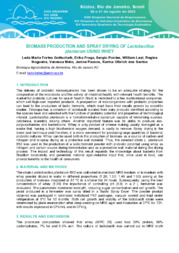Biomass production and spray drying of lactobacillus plantarum using whey.
Biomass production and spray drying of lactobacillus plantarum using whey.
Author(s): GOTTSCHALK, L. M. F.; SOUZA, E. F. de; PONTES, S. M.; LEAL JUNIOR, W. F.; NOGUEIRA, R. I.; MELLO, V. F. de; SILVA, J. P. L. da; SANTOS, K. M. O. dos
Summary: The delivery of probiotic microorganisms has been shown to be an adequate strategy for the composition of the microbiota and the activity of intestinal health, with relevant health benefits. The market for probiotic cultures for use in food in Brazil is restricted to a few multinational companies, which sell high-cost imported products. A prospection of microorganisms with probiotic properties can lead to the production of lactic ferments, which must have their results proven by scientific studies. Embrapa has a collection of lactobacilli isolated from dairy products identified according to the species level and selected with the function of probiotic potential and properties of technological interest. Lactobacillus plantarum is a homofermentative bacterium capable of fermenting sucrose, cellobiose, mannitol, among others. Another important feature was its ability to produce exo- polysaccharides and bacteriocins. Whey is a by-product of cheese making usually managed as a waste that, having a high biochemical oxygen demand, is costly to remove. Spray drying is the lower cost technique and therefore, it is more convenient for producing large quantities of bacterial probiotic cultures. Whey can be used both in the production of biomass as a source of carbon and nitrogen and in spray drying as a protective wall material. Thus, the selected strain L. plantarum B12 was used in the production of a lactic ferment powder with probiotic potential using whey as nitrogen and carbon source during fermentation and as a protective wall material during the drying process. The impact and technology of this result expands the knowledge about bacteria from Brazilian biodiversity and generates nation
Publication year: 2022
Types of publication: Paper in annals and proceedings
Unit: Embrapa Food Technology
Observation
Some of Embrapa's publications are published as ePub files. To read them, use or download one of the following free software options to your computer or mobile device. Android: Google Play Books; IOS: iBooks; Windows and Linux: Calibre.
Access other publications
Access the Agricultural Research Database (BDPA) to consult Embrapa's full library collection and records.
Visit Embrapa Bookstore to purchase books and other publications sold by Embrapa.

